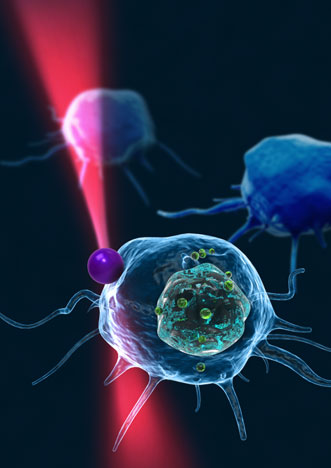A new optical diffraction tomography (ODT) technique can measure the positions of optically trapped particles in three dimensions at high speed.
The method provides a more streamlined and precise way to locate and move microscopic particles than traditional optical tweezer approaches. Developed at the Korea Advanced Institute of Science and Technology (KAIST), it also enables holographic analysis of the particles’ inner structures.
Optical tweezers have been used to exert microscale force on microscopic particles and for manipulating the positions of particles. Employing a tightly focused laser with a diameter of less than 1 μm, an optical tweezer works hand in hand with an optical microscope. Once the microscope measures the light signals scattered by the optically trapped microscopic particles and the positions of the particles in two dimensions, the optical tweezer can then hold the microscopic particles and freely move them to other locations.

Concept image of an optically trapped glass bead on the cellular membrane of a white blood cell. Courtesy of the Korea Advanced Institute of Science and Technology.
However, there always has been difficulty in quantifying any such particle’s precise position along the optic axis and the direction of the beam from a single image. The problem is analogous to the difficulty of determining the front and rear positions of objects with one eye closed due to a lack of depth perception. Furthermore, it is more difficult to precisely measure positions when light signals are distorted by optically trapped particles that have complicated shapes or when other particles occlude the target object along the optic axis.
The new method uses a principle of ODT similar to x-ray computed tomography (CT) imaging, which commonly is used in hospitals to visualize internal organs. Both approaches produce a 3-D image by taking several images from various illumination angles.
The KAIST team used optical tweezers to trap a 2-μm-diameter glass bead and move it toward a white blood cell, which has complex internal structures. The team measured the 3-D dynamics of the white blood cell as it responded to the approaching glass bead via ODT at an acquisition rate of 60 images per second. Since the white blood cell blocks the glass bead along an optic axis, a conventional optical microscope would not be able to determine the bead's position. In contrast, the new ODT method precisely located the bead, as well as measuring the internal materials of the bead and white blood cell simultaneously.
"Our technique has the advantage of measuring the 3-D positions and internal structures of optically trapped particles in high speed without labelling exogenous fluorescent agents and can be applied in various fields including physics, optics, nanotechnology and medical science," said professor YongKeun Park.
Researcher and lead author Kyoohyun Kim added, "This ODT technique can also apply to cellular-level surgeries where optical tweezers are used to manipulate intracellular organelles and to display in real time and in 3-D the images of the reaction of the cell membrane and nucleus during the operation or monitoring the recovery process of the cells from the surgery."
The research was published in Optica (doi: 10.1364/Optica.2.000343).
For more information, visit www.kaist.edu.